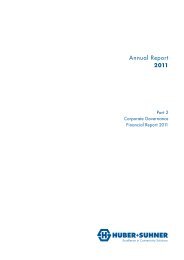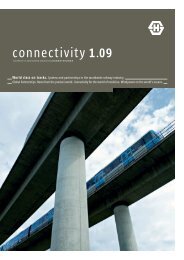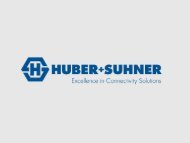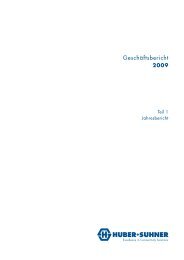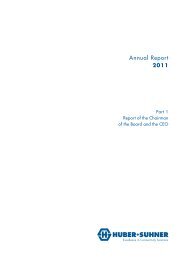Annual Report
Annual Report
Annual Report
You also want an ePaper? Increase the reach of your titles
YUMPU automatically turns print PDFs into web optimized ePapers that Google loves.
Share-based payments<br />
Part of the compensation for members of the Board and<br />
Group Management is paid in HUBER+SUHNER AG<br />
shares, which are valued at market price and have a lock-in<br />
period with a minimum of three and a maximum of ten<br />
years. These shares are assigned after closing of the business<br />
year normally in March or April of the following year.<br />
The market value of the shares is fully accrued in accordance<br />
with the accrual principle and the yearlong vesting<br />
period in the accounts of the respective year under review.<br />
2.17 Shareholders’ equity<br />
Ordinary shares are classified as equity. Where a Group<br />
company purchases the Company’s equity share capital<br />
(Treasury shares), the consideration paid, including any<br />
directly attributable incremental costs (net of income<br />
taxes), is deducted from equity attributable to the Company’s<br />
equity holders until the shares are cancelled or<br />
reissued. Where such shares are subsequently reissued,<br />
any consideration received, net of any directly attributable<br />
incremental transaction costs and the related income tax<br />
effects, is included in equity attributable to the Company’s<br />
equity holders.<br />
2.18 Revenue recognition<br />
Revenues from sales of products are recognised upon<br />
making delivery. Delivery is made if risks and rewards are<br />
transferred. Sales are shown as a net amount in the income<br />
statement. They represent the total value of invoices to<br />
third parties reduced by sales taxes, credits for returns and<br />
reductions of revenue (primarily rebates and discounts).<br />
2.19 Research and development expenses<br />
Research and development costs are recognised as an<br />
expense in the period in which they are incurred. Development<br />
costs are capitalised if specific criteria are met<br />
and the capitalised amount can be covered through corresponding<br />
future cash flows.<br />
2.20 Income taxes<br />
Income taxes are accounted for on the basis of the income<br />
of the reporting year, less the utilisation of tax losses carried<br />
forward, using expected actual (local) tax rates.<br />
Deferred income tax is provided in full, using the liability<br />
method, on temporary differences arising between the tax<br />
bases of assets and liabilities and their carrying amounts in<br />
the consolidated financial statements. Deferred income tax<br />
is determined using tax rates and laws that have been enacted<br />
or substantially enacted at the balance sheet date and<br />
are expected to apply when the related deferred income<br />
tax asset is realised or the deferred income tax liability is<br />
settled.<br />
Notes to Group Financial Statements<br />
HUBER+SUHNER <strong>Annual</strong> <strong>Report</strong> 2010 · Part 2<br />
Deferred income tax assets are recognised only to the<br />
extent that it is probable that future taxable profit will be<br />
available against which the temporary differences can be<br />
utilised.<br />
Deferred income tax is provided on temporary differences<br />
arising on investments in subsidiaries and associates, except<br />
where the timing of the reversal of the temporary difference<br />
is controlled by the Group and it is probable that<br />
the temporary difference will not reverse in the foreseeable<br />
future.<br />
2.21 Cash flow statement<br />
The cash flow from operating activities is calculated according<br />
to the indirect method. The funds consist of cash<br />
and cash equivalents.<br />
The free cash flow is calculated based on net cash flow<br />
from operating activities less the cash flow from investing<br />
activities (excluding changes of marketable securities and<br />
derivative financial instruments), less payments to shareholders<br />
and purchase of treasury shares.<br />
2.22 EBIT<br />
The EBIT is the operating result before finance costs, income<br />
and expenses relating to financial assets and liabilities<br />
such as currency translation effects, interest or marketable<br />
securities income and before current and deferred taxes.<br />
3 Financial risk management<br />
3.1 Risk assessment<br />
The risk management system of the HUBER+SUHNER<br />
Group and of all Group companies is laid down in the<br />
Board of Directors’ risk strategy and the Executive Group<br />
Management’s guidelines on the risk management process.<br />
Based on its own assessment (top-down) and on information<br />
provided by the Divisions and subsidiaries (bottomup),<br />
Executive Group Management has reviewed in the<br />
reporting year the status and impact of actions decided earlier<br />
and has selected and reassessed the most significant financial,<br />
operational and strategic risks. These risks together<br />
with the ongoing and new actions have been submitted in<br />
the Risk <strong>Report</strong> 2010 to the Board of Directors for review<br />
and approval. After an in-depth discussion, the Board of<br />
Directors has agreed with the risk assessment 2010 and has<br />
approved the risk report on 1 December 2010.<br />
3.2 Risk policy<br />
As a global industrial corporation with manufacturing and<br />
sales subsidiaries in several countries, HUBER+SUHNER<br />
is exposed to various financial, market and credit risks of<br />
strategic, operational and financial nature. As part of the<br />
scope of the corporate risk process, corporate management<br />
monitors these risks constantly and makes every effort to<br />
minimise negative influences on the Group and especially<br />
on the financial results. HUBER+SUHNER also uses derivative<br />
financial instruments to hedge specific financial<br />
risks. All hedging transactions are always connected with<br />
existing assets and liabilities or with future business transactions<br />
that are extremely likely to take place.<br />
23





